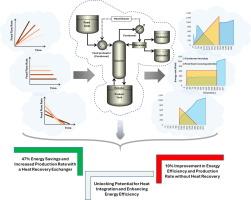Heat integration and process improvement of a batch distillation unit using a gradual feeding strategy: A case study on MIBK-water separation
IF 8.1
1区 工程技术
Q1 ENGINEERING, CHEMICAL
引用次数: 0
Abstract
This work focuses on upgrading a batch distillation unit in terms of energy efficiency and production capacity. Dehydration of methyl isobutyl ketone (MIBK) is performed as a case study. Since the MIBK-water mixture forms a heteroazeotrope, a decanter is applied to facilitate the separation process. The unit performance is evaluated in terms of specific product flow (SPF) and specific energy cost (SEC). Studying the impact of feed quantity in the range of 20 to 80 kg showed that due to the almost equal holdup loss, a larger batch feed quantity results in higher energy efficiency and production performance. Gradual feeding policy with different feeding strategies and locations (i.e., top feeding and bottom feeding) is also assessed in detail and compared with the conventional batch distillation process. Also, three feeding rate profiles (increasing, fixed, and decreasing) with varying feeding durations are evaluated in order to reach the optimal feeding time and profile. Overall, gradual feeding is found to be an efficient approach to upgrade the unit operation in terms of energy efficiency and production rate. Top feeding (also known as batch stripping or inverted batch distillation) has proved to be a more efficient policy for MIBK-water separation over bottom feeding. In addition, the decreasing feed flow rate scenario offers a more efficient operation compared to other feed rate profiles. Accordingly, employing the top feeding policy with a decreasing feed rate profile can lead to a 10 % improvement in production rate and energy cost over a conventional batch distillation unit equipped with a decanter. Moreover, based on the gradual feeding approach, a novel and easy-to-apply strategy for heat integration and recovery in the batch distillation process is proposed, and its potential is assessed for different feeding scenarios. The proposed strategy is also found to be significantly effective in process intensification and acceleration. Applying this strategy to a batch distillation unit with top feeding at a fixed feed rate offers over 47 % improvement in energy efficiency and production rate compared to a conventional batch distillation unit equipped with a decanter.


求助全文
约1分钟内获得全文
求助全文
来源期刊

Separation and Purification Technology
工程技术-工程:化工
CiteScore
14.00
自引率
12.80%
发文量
2347
审稿时长
43 days
期刊介绍:
Separation and Purification Technology is a premier journal committed to sharing innovative methods for separation and purification in chemical and environmental engineering, encompassing both homogeneous solutions and heterogeneous mixtures. Our scope includes the separation and/or purification of liquids, vapors, and gases, as well as carbon capture and separation techniques. However, it's important to note that methods solely intended for analytical purposes are not within the scope of the journal. Additionally, disciplines such as soil science, polymer science, and metallurgy fall outside the purview of Separation and Purification Technology. Join us in advancing the field of separation and purification methods for sustainable solutions in chemical and environmental engineering.
 求助内容:
求助内容: 应助结果提醒方式:
应助结果提醒方式:


